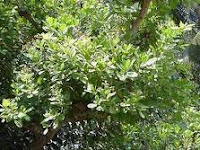CAT MINT, CATNIP, NEPETA CATARIA
Cat nip or catnep or cat mint is a member of the
mint family as its name suggests, and there are more than 200 varieties growing around the world.
Nepeta cataria grows wild in Britain in fields and hedgerows and wherever it can get a hold. Other Nepeta varieties grow in the Indian subcontinent in temperate and tropical zones; are common in North America, where catnip is not thought to be an indigenous plant, and throughout Europe.
You may have thought that its purpose on the planet was to keep cats happy, but as it turns out you would be wrong in assuming this.
To our non-feline sense of smell it is a bit like mint or perhaps like
pennyroyal, but the essential oil it produces is very attractive to moggies. The main constituent of this oil is nepetalactone which is an effective mosquito and cockroach repellent. It is also an effective antimicrobial and works against fungi and bacteria. Rats are said not to go anywhere near catnip, although this might be because of the frequent feline visitors to it, but it acts as a good deterrent to these rodents, whatever the case. Cats are attracted to plants whose leaves have been bruised and exhibit signs of sexual excitement when they get a whiff of it. They rub against the plant then roll around on it so destroying the plant in the process. If you have an old pet cat or an obese one, don’t plant catnip in your garden. The stimulation might be too much for it.
There is an interesting old rhyme; -
“If you set it, the cats will eat it,
If you sow it, the cats don’t know it.”
 |
| Catnip Seeds |
This has been observed to be true. If you transplant catnip, cats will soon destroy it, but if you plant it from seeds they don’t seem to bother with it. This might be because the smell of a transplanted catnip plant will exude because of bruising caused to the plant and leaves in the transportation of it.
Before the introduction of tea to the British Isles, people used to make catnip tea, and this was used for a variety of purposes. For one thing it is hallucinogenic (mildly) and has been smoked with tobacco or alone as a substitute for marijuana. These days as
cannabis is more easily attainable, it has fallen into disuse as a drug of this kind, but it does produce a state of calmness apparently, and has been used as a “cigarette” for respiratory ailments, including asthma.
Catnip leaves may be chewed to relieve toothache, and if you chew the roots you may become quarrelsome and fierce. There is an old tale about a hangman who was a very mild person and who had to chew the root to get up his courage to hang someone.
It has been used to relieve hysterics and insanity in the past and Sydenham (1624-1689) wrote that its effects were probably because of its “strong and noisome smell, to recall the exorbitant and deserting Spirits to their proper Stations.”
Culpeper wrote that “the juice drunk in wine is good for bruises” and the fresh juice can be used as an emmenogogue and for stomach pains. Culpeper also wrote that “the green leaves bruised and made into and ointment is effectual for piles” and “the head washed in a decoction taketh away scabs, scurf etc.”
The flowering tops of the plant have traditionally been used in medicine, and they have a refrigerant or cooling effect on the body, as well as being useful as a mild emmenogogue especially used for stomach cramps. It induces sweating so is a diaphoretic, and is mildly stimulating to humans. It has been used to cure sleeplessness, restlessness, colic, headaches and the young tops are good to stop nightmares. The tea or tisane helps with flatulence problems and to produce sweat during fevers.
If you use equal parts of
saffron and catnip tisane it is allegedly good for smallpox, scarlet fever, colds and hysterics. The plant has also been used traditionally to relieve yellow fever and jaundice.
Catnip can also be found in toys for pet cats, and the powdered roots, seeds and dried or fresh leaves are good in tisanes, to help in the cases of the illnesses mentioned above. You can add catnip leaves to soups, stews and sauces for their flavour.

There is a story about a restaurateur in the Loire valley (France) who was keen to get a highly coveted Michelin star when the Michelin man visited the region. A friend gave him a tip off to say which day the man would come and he prepared a dish especially for him. One man went to the restaurant and the owner assumed this was the person who recommended restaurants for the Michelin Guide. Unfortunately most things that could go wrong did and the man walked out of the restaurant in high dudgeon. The owner, who was also the chef, yelled at his wife and kicked his heavily pregnant cat, which ran off. Later when he had calmed down he apologized to his wife, but couldn’t find the pet cat. Determined to make amends, he cooked a chicken dish for the cat to entice it back and laced it liberally with catnip. Off he went with some of this dish, leaving the rest in his kitchen. When he got back there was the actual man from Michelin who was enthusing about the chicken dish. He said that he would give the restaurant two stars on the quality of the dish alone, but three if the man would tell him his secret ingredient. The man declined to do so, as he didn’t want the Michelin man to know it had been cooked with a feline in mind, and might withdraw the offer of the stars. The man was delighted and awarded the restaurant three stars because good chefs never reveal their culinary secrets. Now the man had to decide what to call the dish and as he was pondering the cat came back carrying a kitten in its mouth. The cat went away again and came back eventually with twelve more kittens. So the dish was called “Chicken Surprise Thirteen Kittens”.
I don’t know if this is true or not, but it’s a good urban legend and apropos to this post.
CATNIP TISANE
Ingredients
1 oz fresh leaves or flowering tops
1 pint boiling water
Method
Pour the boiling water on the catnip and leave to steep, covered, for 15 minutes. You can drink it like a tea, but this might have sedative effects or hallucinatory ones (visual and or auditory) depending on its strength.
For medicinal purposes adults should have a tbsp dose three times a day for headaches, to induce sweating during colds or fevers etc. Children with colic can have 2 tsps.
This has Taste and is a Treat(ment).












































